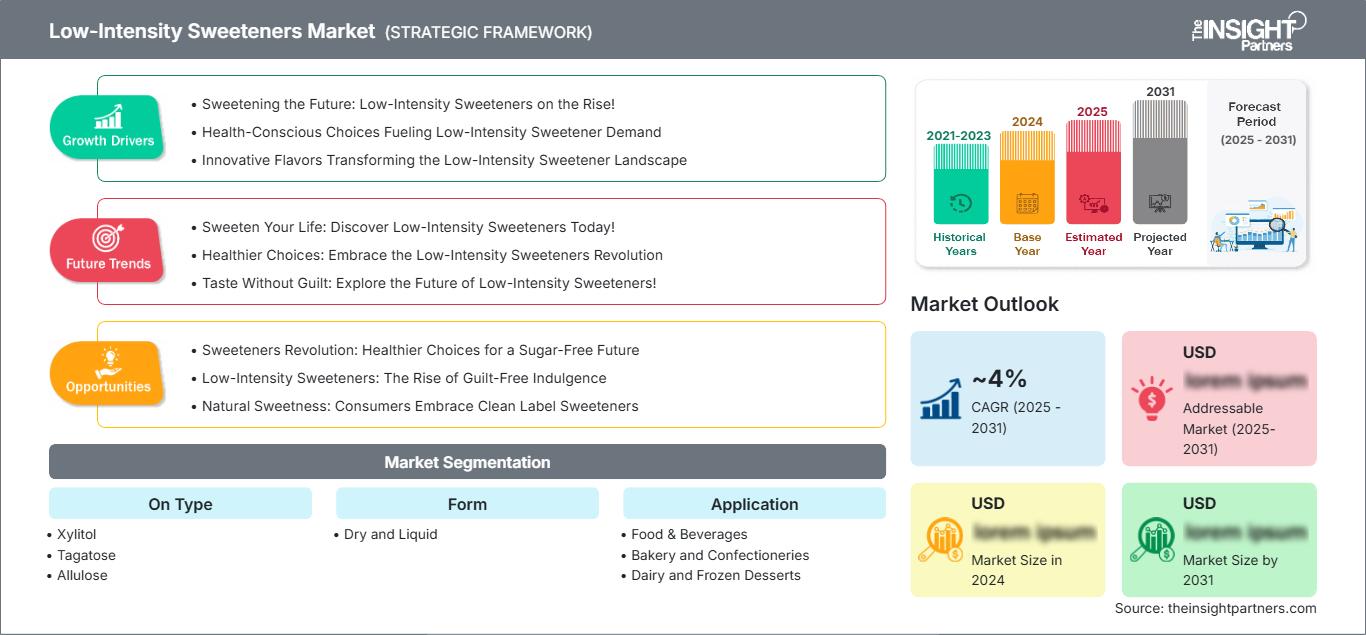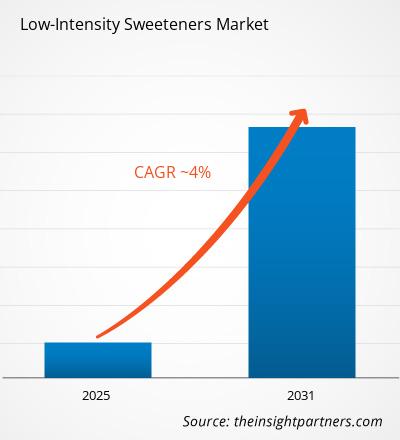低甘味料市場は、2025年から2031年にかけて約4%のCAGRで成長し、市場規模は2024年のXX百万米ドルから2031年にはXX百万米ドルに拡大すると予想されています。
本レポートは、タイプ別(キシリトール、タガトース、アルロース、トレハロース、イソマルトース)に分類し、さらに形態別(乾燥および液体)で市場を分析しています。また、用途別(食品・飲料、ベーカリー・菓子、乳製品・冷凍デザート)にも市場を分析しています。これらの主要セグメントそれぞれについて、世界、地域、国レベルで包括的な内訳を提供しています。
本レポートには、全セグメントの市場規模と予測が含まれており、価格は米ドルで表示されています。さらに、主要企業の現在の市場状況に関する主要統計に加え、現在の市場動向や新たな機会に関する洞察も提供しています。
報告書の目的
インサイト・パートナーズによる低甘味度甘味料市場レポートは、現在の市場状況と将来の成長、主要な推進要因、課題、そして機会を解説することを目的としています。これにより、以下のような様々なビジネスステークホルダーに洞察を提供します。
- テクノロジープロバイダー/メーカー: 進化する市場の動向を理解し、潜在的な成長機会を把握することで、情報に基づいた戦略的意思決定を行えるようにします。
- 投資家: 市場の成長率、市場の財務予測、バリュー チェーン全体に存在する機会に関する包括的な傾向分析を実施します。
- 規制機関: 市場の濫用を最小限に抑え、投資家の信用と信頼を維持し、市場の健全性と安定性を維持することを目的として、市場における政策と警察活動を規制します。
低甘味料市場のセグメンテーション
タイプについて
- キシリトール
- タガトース
- アルロース
- トレハロース
- イソマルトース
形状
- 乾燥と液体
応用
- 食品・飲料
- パン屋・菓子店
- 乳製品と冷凍デザート
このレポートの一部、国レベルの分析、Excelデータパックなど、あらゆるレポートを無料でカスタマイズできます。また、スタートアップや大学向けのお得なオファーや割引もご利用いただけます。
低甘味度甘味料市場:戦略的洞察

- このレポートの主要な市場動向を入手してください。この無料サンプルには、市場動向から見積もりや予測に至るまでのデータ分析が含まれます。
低甘味度甘味料市場の成長要因
- 未来を甘くする:低甘味料の増加!
- 健康志向の選択が低甘味料の需要を刺激
- 低甘味料市場を変革する革新的なフレーバー
低甘味料市場の将来動向
- 人生を甘くしましょう: 低甘味料を今すぐ発見しましょう!
- より健康的な選択:低甘味料革命を受け入れよう
- 罪悪感なく味わおう:低甘味料の未来を探ろう!
低甘味料市場の機会
- 甘味料革命:砂糖のない未来のためのより健康的な選択
- 低甘味料:罪悪感のない贅沢の台頭
- 自然な甘さ:消費者はクリーンラベル甘味料を好む
低甘味度甘味料市場の地域別分析
予測期間全体を通して低甘味料市場に影響を与える地域的な傾向と要因は、The Insight Partnersのアナリストによって徹底的に説明されています。このセクションでは、低甘味料市場のセグメントと地域についても、北米、ヨーロッパ、アジア太平洋、中東・アフリカ、中南米に分けて解説しています。
低甘味料市場レポートのスコープ
| レポート属性 | 詳細 |
|---|---|
| 2024年の市場規模 | XX百万米ドル |
| 2031年までの市場規模 | XX百万米ドル |
| 世界のCAGR(2025年~2031年) | 約4% |
| 履歴データ | 2021-2023 |
| 予測期間 | 2025~2031年 |
| 対象セグメント | タイプ別
|
| 対象地域と国 | 北米
|
| 市場リーダーと主要企業の概要 |
|
低甘味料市場のプレーヤー密度:ビジネスダイナミクスへの影響を理解する
低甘味度甘味料市場は、消費者の嗜好の変化、技術の進歩、製品の利点に対する認知度の高まりといった要因によるエンドユーザーの需要増加に牽引され、急速に成長しています。需要の増加に伴い、企業は製品ラインナップの拡充、消費者ニーズへの対応のための革新、そして新たなトレンドの活用を進めており、これが市場の成長をさらに加速させています。

- 低甘味料市場のトップキープレーヤーの概要を入手
主なセールスポイント
- 包括的なカバレッジ:レポートでは、低強度甘味料市場の製品、サービス、種類、エンドユーザーの分析を包括的にカバーし、全体的な展望を提供します。
- 専門家の分析:レポートは、業界の専門家とアナリストの深い理解に基づいて作成されています。
- 最新情報: このレポートは、最新の情報とデータの傾向を網羅しているため、ビジネスの関連性を保証します。
- カスタマイズ オプション: このレポートは、特定のクライアント要件に対応し、ビジネス戦略に適切に適合するようにカスタマイズできます。
したがって、低甘味料市場に関する調査レポートは、業界の状況と成長見通しを解明し、理解するための先導役となるでしょう。いくつかの妥当な懸念事項はあるものの、このレポートの全体的なメリットはデメリットを上回る傾向にあります。
- 過去2年間の分析、基準年、CAGRによる予測(7年間)
- PEST分析とSWOT分析
- 市場規模価値/数量 - 世界、地域、国
- 業界と競争環境
- Excel データセット
最新レポート
お客様の声
購入理由
- 情報に基づいた意思決定
- 市場動向の理解
- 競合分析
- 顧客インサイト
- 市場予測
- リスク軽減
- 戦略計画
- 投資の正当性
- 新興市場の特定
- マーケティング戦略の強化
- 業務効率の向上
- 規制動向への対応




















 無料サンプルを入手 - 低甘味料市場
無料サンプルを入手 - 低甘味料市場